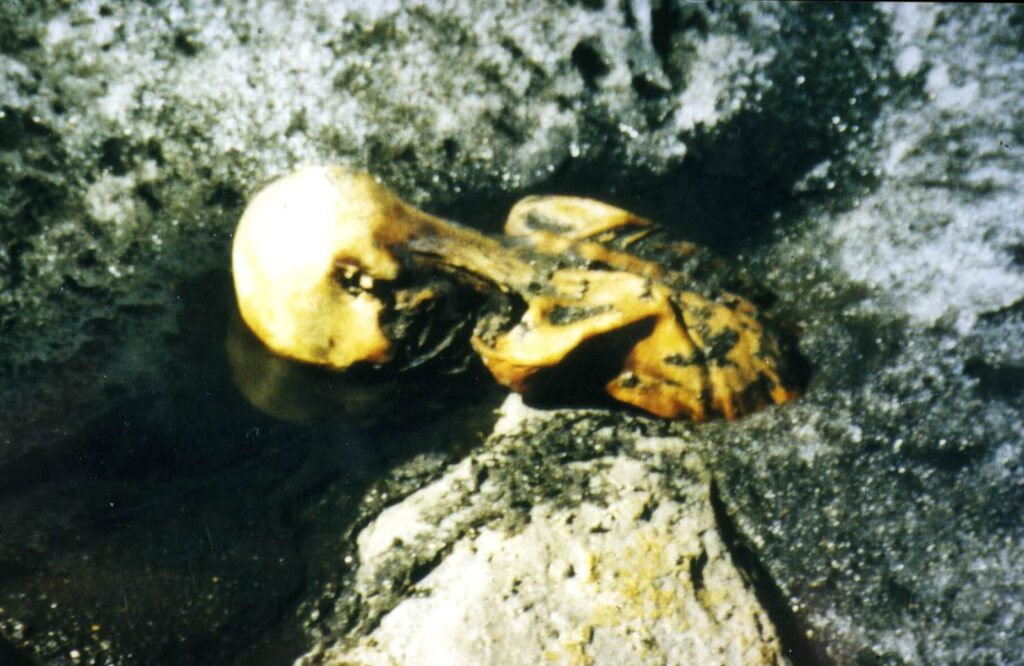Glacial archaeologists often get the question: “What would you most like to find?” Let’s be honest: We would all like to find an ice mummy like Ötzi. There is so much information we can gain from such a rare find. Analysis of ancient ice mummies can tell us when and where they lived. We get information on what they ate in the last days prior to dying. We learn about diseases they had, and why they died. And this is just for starters.
Ötzi
Ötzi, the iceman from the Tyrolean Alps, is the holy grail of glacial archaeology. He became a world-wide sensation after the discovery of his mummified body in 1991. Each year, 250000 people visit the Ötzi museum in Bolzano. We published an extensive post on Ötzi here, where we discuss both the find itself and the scientific problems with the official Ötzi story.

Why are ice mummies so rare?
People did not realize initially that Ötzi was a very old ice mummy. Back in 1991, people had no idea that ice could preserve human bodies for such a long time. This lack of understanding led to unfortunate damage to the mummy and the artefacts during the recovery. To avoid such calamities, we have prepared a mummy-kit and a contingency plan if an ice mummy should appear in our own mountains here in Norway. However, the chances of finding an ice mummy are low and our mummy-kit is still unused.
The absence of ice mummies is not for the lack of people dying in the high mountains. Obviously, people died in the high mountains in the past – in blizzards, accidents, due to violence, or for purely natural reasons (more here). So why are there not more finds like Ötzi?
The answer is that it would take a number of preconditions for their bodies to preserve until today. First, the body would have to be lost, so that relatives could not recover it for proper burial. Secondly, the death would have to take place on non-moving ice (ice patches), allowing the ice to preserve the body without crushing it. Thirdly, the body would have to stay on the surface for an initial freeze-drying before being encapsulated in the ice, without scavengers destroying it in the meantime. As you can see, the chances of making it as an ice mummy are really slim.
Mummies from the White War
The initial freeze-dyring on the surface preserved Ötzi for posterity. Without this natural mummification process, the decomposition of his body would have continued even inside the ice. This is demonstrated by the decomposed bodies of WWI soldiers found in the ice of the high alpine battlefields of the White War in Süd-Tyrol (check the stories in National Geographic and Motherboard, based on an article in the Telegraph Magazine by Laura Spinney).
The closest to an ice mummy we got so far here in Innlandet County, Norway, was the find of a Viking sword at high altitude in the Reinheimen Mountains in 2017. A likely explanation of this find is that the owner died of exposure after losing his way in a blizzard. If he had made it to the ice patch a bit further east, we could have had a Viking ice mummy. The thought of that makes my head spin (read the story here).
Human remains from the glaciers in the Alps.
The glacial ice of the Alps contains hundreds of human bodies, mostly from the 20th century. They are the result of people falling into crevasses while crossing glaciers. When the Alpine summer is especially warm, some of these remains melt out. On rare occasions, older human remains appear as well, such as the 17th century finds of human remains from the Porchabella Glacier and the Theodul Glacier. However, these human remains are in a skeletonized state with scattered bones, not ice mummies. This is a result of the bodies having been inside moving glaciers, which both tear them apart and intermittently expose them to air. We covered these two finds and other examples of deaths in the high mountains in this post.
Kwäday Dän Ts’ìnchi
Human remains from glacial ice also exist in North America. Two hunters discovered partly mummified human remains and artefacts on a glacier in a remote mountain range in British Columbia in 1999. The Canadian iceman received the name Kwäday Dän Ts’ìnchi – “The Long Ago Person Found” by the local First Nations. Radiocarbon dates show that he died sometime between AD 1720 and 1850. The human remains are not exhibited like Ötzi, but were cremated and buried near the find spot.
Human bodies from permafrost ice
Discoveries of frozen human bodies also happen outside glaciers and ice patches. Permafrost ice can preserve human bodies in a nearly pristine state. The Arctic holds a large number of permafrost graves belonging to European explorers and whalers. A famous example is the three 19th century graves of seamen from the ill-fated Franklin expedition in the Canadian Arctic. We take an in-depth look here.
Permafrost ice preserves incredible burials of the Pazyryk culture in the Altai Mountains of Russia and Mongolia. The burials, which are from the 4th and 3rd century BC, consist of wooden chambers covered by large cairns of stone. The cairns produced a cooling effect, leading to the development of permafrost ice below. This preserved the human remains and the organic artifacts from the burials. The preservation of the human remains is varying, but a number of the burials have preserved skin with elaborate tattoos.
Freeze-dried human bodies
Cold and dry conditions can also preserve human bodies due to freeze-drying – a natural mummification process. The Incas sacrificed children on mountain tops in the Andes, and some of these preserved as mummies. Graves in rock shelters in Greenland contained inuit mummies. We covered these types of mummies in this post.
